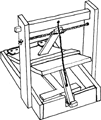Vertebrate Pest Conference Proceedings collection
Date of this Version
March 1992
Document Type
Article
Abstract
Bandicota bengalensis, a predominant species inhabiting irrigated fields is a potential pest on agricultural crops and is known to live in extensive burrow systems. The burrow opening covered with mud which is an indicator of its activity seems to be discontinuous. An analysis of burrow systems and their occupations indicated reuse of abandoned burrow systems by new entrants. A study simulated in semi-natural conditions supported the view that there is occupation of old burrows by new immigrants. Non-effective barriers; and availability of Panicum repens on bunds, a food alternative may support the population influx. Availability of old burrow systems due to chemical control and natural predation often result in a ready made habitat for the immigrants, and new recruits to reinfest the irrigated fields. Total dismantling of the burrow system and agricultural practices in irrigated field retards the reinfestation.


